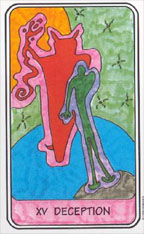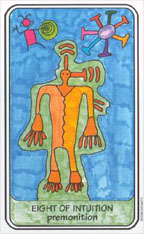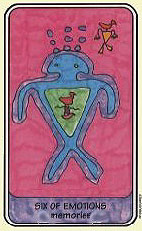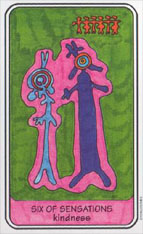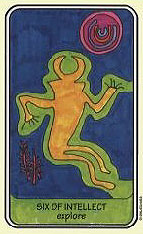Rock Art Tarot Deck Review
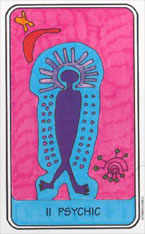
The Rock Art Tarot deck uses ancient petroglyphs as symbols and archetypes. Symbols were used from around the world and the deck is based solely on the intuitive structure decided upon by the deck creator. The artwork looks as though it was coloured in with felt pens, and the choice of colours is unusual.
Deck Type: Tarot Deck Cards: 78
Creators: Jerry Roelen
Publisher: US Games 1996
Retailers
See Price at Amazon.comSee Price at Amazon.co.uk
See Price at Amazon.co.uk (Set)
Rock Art Tarot Review by Formicida
The Rock Art Tarot features brightly colored renditions of rock art. The images are drawn from petroglyphs, pictographs, and intaglios from around the world. The artist and author, Jerry Roelen, spent thirty years visiting rock art sites before creating the deck. The interpretations of the images that form the core of the deck are derived from her own intuitive sense of their meanings and not from any traditional source. She says in the LWB, “My emphasis here is on what they represent to me metaphysically; only their original artists know their true purposes and meanings.”
Most of the cards have been renamed, but the connection to the Rider-Waite-Smith system is generally obvious. In general, the changed names typically reflect a more abstract description of the archetype that the card expresses, rather than the more allegorical approach in traditional decks. For example, the Fool is called “Innocence,” and the Tower is “Unexpected.”
The four suits are intuition, emotions, intellect, and sensations, corresponding to wands, cups, swords, and pentacles, respectively. Obviously, there is no attempt to show the appropriate number of any suit implement on the numbered cards. The court cards, which Roelen calls “Guardian Spirits,” are called Mankind, Womankind, Peacemaker, and Defender. Mankind and Womankind seem to take on the attributes of the King and Queen, respectively. Although Peacemaker and Defender are listed in that order, the descriptions in the book make the Peacemaker appear to have the qualities of a Page, while the Defender has the qualities of a Knight.
Each of the Minor Arcana cards also has a keyword on it, below the card name. The keywords on the guardian spirit cards are generally adjectives describing a type of person, which might be helpful for people who have trouble reading court cards in traditional decks. For example, the Defender of Intuition (equivalent to the Knight of Wands) is “impetuous;” Mankind of Emotions (King of Cups) is “charismatic.” The keywords largely seem to be based on the RWS system, although there are some exceptions: the Nine of Intuition (Wands) is titled “foresight,” which is not typically a characteristic one would associate with the Nine of Wands. Oddly, both the Four of Intuition and the Ten of Sensations are “prosperity.”
The cards are a comfortable size, slightly larger than normal, at 4 5/8 x 2 7/8 inches (11.8 x 7.5 cm). They feel sturdy and slide over each other comfortably during shuffling. The backs are reversible and very much in keeping with the feeling and style of the deck. They show a doubled rock art image (not in any of the cards) on a green background.
The LWB gives a one-paragraph introduction to the cards, as well as basic divinatory meanings and two spreads. The expanded companion book gives a good deal more information, and I think it is probably worth getting the book and deck set. The first chapter of the companion book is titled “Rock Art History,” but actually has some explanations of rock art terminology before giving descriptions of rock art around the world, divided by geographical region. The second chapter contains black and white photographs of some of the rock art that Roelen incorporated into the deck. Chapter 3 gives advice about Tarot reading.
Chapter 4 is the bulk of the book, containing card descriptions. The divinatory meanings are basic lists of single words and short phrases, identical to those in the LWB. However, the larger book contains descriptions of the symbols used in the card and a “forewarning” which expands the divinatory meanings into advice. The expanded information is still fairly short, but can be very helpful in explaining what the artist saw in the sometimes mysterious images. In some cases, the keyword on the card seems incongruous with the image, and it is helpful to have an explanation of what the artist saw in the image. For example, the main image on the Four of Emotions is a couple including a heavily pregnant woman, and the keyword is “confused.” The book describes the image: “Two figures hold hands, while confused thoughts and a vision of childbirth emerge.” I assume that the “confused thoughts” are the symbols above the heads of the couple, which include a snakelike object, a spiral, and three things that look like splotches of paint. I don't find this explanation to be completely compelling, but it is more satisfying than the divinatory meanings alone.
In chapter 5 of the companion book, there are three spreads. One is the calendar spread, which deals 1-3 cards in a circle for each month of the coming year. One is the “shining star spread,” an 11-card spread that I had never seen before, and which has no further description in the book. The last is a 30-card spread based on the 10 of Sensations from the Rock Art Tarot itself. The introduction to the spread says that it “represents the physical, spiritual, and mental success available in this incarnation.” It looks like a very detailed and interesting spread, and a good challenge for people who like large spreads. Finally, chapter 6 contains a list of the cards with the geographic locations from which the symbols were taken. Finally, the book contains a glossary of terms and a bibliography.
Readers who don't like primitive art will be put off by this deck, but I think Roelen has done a very good job of revitalizing this ancient artform with modern colors and interpretations. There's a good deal of depth to the images that doesn't meet the eye immediately. This deck is probably not suitable for a beginner, because the cards don't always correspond to any existing system and are often difficult to interpret intuitively. However, more advanced readers who want a challenge to their intuition and who appreciate primitive art may find the Rock Art Tarot to be an underappreciated gem.
Complete Details of Rock Art Tarot
Creators: Jerry RoelenPublisher: US Games 1996
Deck Type: Tarot Deck
Cards: 78
Major Arcana: 22
Minor Arcana: 56
Deck Tradition: Unique
Minor Arcana Style: Unique Scenes Without Suit Symbols
Suits: Intellect, Intuition, Emotions, Sensations
Court Cards: Mankind, Womankind, Peacemaker, Defender
Major Titles: 0 Innocence, I Illusion, II Psychic, III Intuition, IV Logic, V Wisdom, VI Lovers, VII Journey, VIII Strength, IX Meditation, X Ritual, XI Justice, XII Transition, XIII Transformation, XIV Harmony, XV Deception, XVI Unexpected, XVII Terrestrial, XVIII Evolution, XIX Illumination, XX Awakening, XXI Eternal
The Fool is 0
Strength is 8
Justice is 11
Card Size: 3.50 x 2.25 in. = 8.89cm x 5.71cm
Card Language: English
Card Back: Reversible
Back Design: Two large shield faces of violet and pink float against a green background. Below each shield walks a red birdman with orange head feathers.
Companion Material: Book.
Rating: 10/20 or
Similar Decks to Rock Art Tarot
< Previous Deck · Back to Top · Next Deck >
Home > Tarot Reviews > Rock Art Tarot Review

